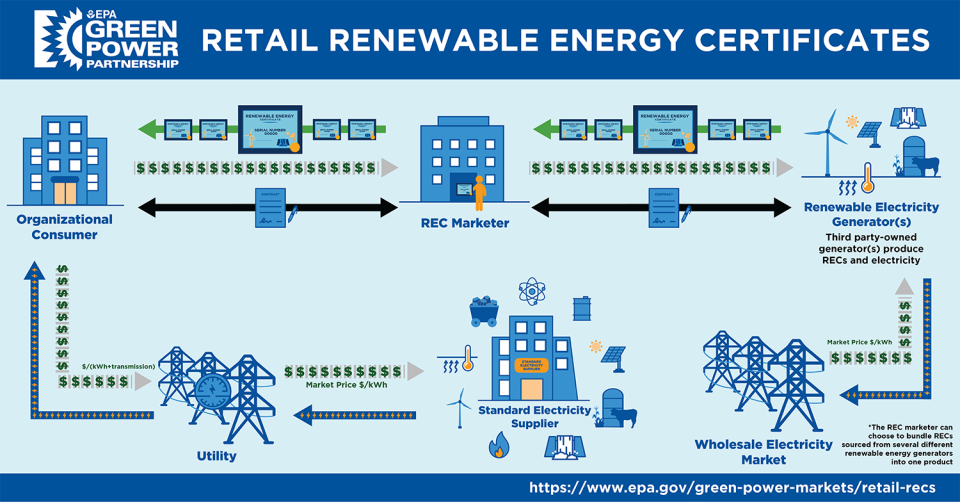Retail RECs
Explore the sections below to learn more about retail renewable energy certificates (RECs).
- What is a Retail REC?
- How do Retail RECs Work?
- What Attributes do Retail RECs Include?
- Advantages and Challenges of Retail RECs
- Additional Resources
What is a Retail REC?
RECs are tradeable, market-based instruments that represent the legal property rights to the "renewable-ness" (i.e. environmental attributes) of one megawatt-hour (MWh) of renewable electricity generation.
A REC is issued for every MWh of electricity generated and delivered to the electric grid from a renewable energy resource. Electricity cannot be considered renewable without a REC to substantiate its renewable-ness. All green power supply options involve the generation and retirement of RECs.
Unbundled retail RECs refer to RECs that are sold, delivered, or purchased separately from electricity. RECs (the instrument) provide no physical delivery of electricity to customers, and as such, a customer buying unbundled retail RECs is purchasing power from a separate entity than the one selling them the REC.
How do Retail RECs Work?
Retail RECs are available nationally and can be sourced from a single type of renewable resource, such as solar, or from a mix of resources, such as 50 percent solar and 50 percent wind. A customer’s REC procurement is not limited by their location or by individual state policies. This flexibility allows organizations to support renewable energy development and protect the environment, even if bundled green power products (e.g., utility green power products) are not locally available.
Customers typically purchase retail RECs for a forward-looking or backward-looking performance period, which is usually 12 months and can cover a calendar year, fiscal year, or other 12-month period. Sold in MWh increments (1 MWh = 1,000 kWh), retail RECs must be from eligible generation dates (pdf) that align with the performance period they are being applied to. Customers often purchase the desired amount in one clump, which generally reduces the transactional cost. Customers usually get to specify what type of renewable resource they would like to purchase RECs from, but generally, the more limitations the consumer puts on the product in terms of specific attributes—such as location of generation and resource mix—the higher the price becomes, as the supplier has fewer options to choose from.
The owner of a REC has exclusive rights to make claims (pdf) about "using" or "being powered with" the renewable electricity associated with that renewable energy generation. Various regional REC tracking systems help verify REC ownership and the right to make environmental claims.
Retail RECs, certified by an independent third party, offer consumers a higher level of certainty about the integrity of their purchase. In meeting specific environmental and customer protection guidelines adopted by the certifying organization, purchasers can be sure that their purchase meets nationally accepted standards for resource and product quality.
The below infographic depicts how a typical Retail REC works.

What Attributes do Retail RECs Include?
Unbundled retail RECs include several data attributes, including renewable resource type, period of generation, first date of generator operation, nameplate capacity of the project, tracking system ID, and renewable generator location. Some RECs also specify the utility that the project is interconnected to, as well as the emissions rate of the renewable resource, among other attributes.
Advantages and Challenges of Retail RECs
Advantages:
- Customers can purchase a large number of RECs in a single contract, thus reducing the transactional costs in purchasing green power.
- These RECs can be a cost-effective green power solution as suppliers are able to source RECs nationally and can select efficient projects in regions with abundant renewable energy resources.
- There is flexibility in procuring green power from sources across the United States, which can be far from the customer.
- Retail RECs are often advantageous for organizations with a dispersed electricity load, such as retail stores or organizations with a national footprint with many stores in various electricity markets.
- Retail RECs generally bought with a short-term contract, which means purchase levels can be adjusted from year to year if the organization's electric load changes.
Challenges:
- Customers must also purchase electricity from another supplier; thus, the purchaser is paying for electricity plus the RECs.
- Organizations should pay close attention to the generation source of their RECs (e.g., wind, solar) and match their green power use claims accordingly.
- Customers often cannot tie their REC purchase directly to a specific project.
- Retail RECs are often sourced from faraway projects, limiting a customer’s ability to make a local economic or environmental impact.
Additional Resources:
- EPA video, 2015 – RECs: Making Green Power Possible
- EPA webinar, 2015 – Understanding RECs and the Green Power Procurement Process
- National Renewable Energy Laboratory, 2015 – Renewable electricity: how do you know you are using it? (pdf)
- Center for Resource Solutions, 2015 – The Legal Basis of RECs (pdf)
